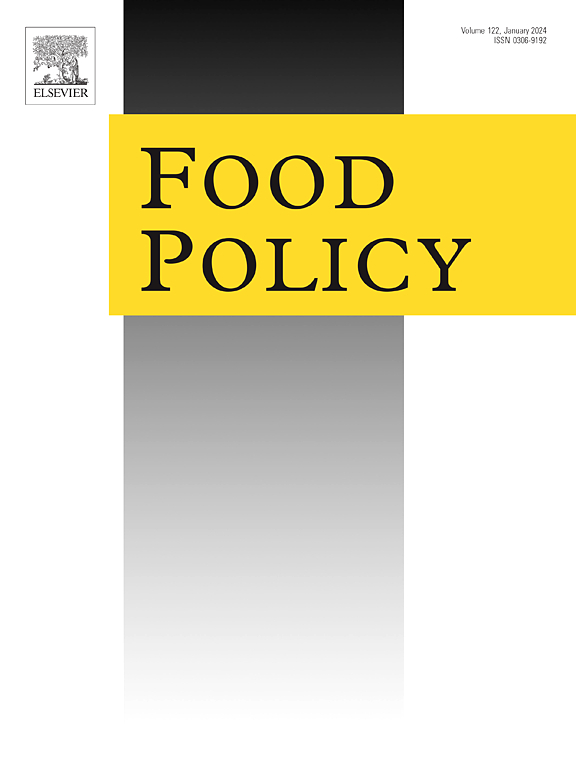通过国际贸易提高营养供应:美国和全球乳品出口到新兴市场
IF 6
1区 经济学
Q1 AGRICULTURAL ECONOMICS & POLICY
引用次数: 0
摘要
本研究考察了通过美国自由贸易协定(FTAs)向中低收入国家(LMICs)分配有营养价值的食品的贸易自由化的重要性。以富含必需营养素并与重要健康益处相关的乳制品为重点,我们构建了24年的双边贸易数据(1998-2021),并添加了营养成分信息。建立了一个结构重力模型来量化美国自由贸易协定内的养分可用性。结果表明,虽然美国自贸协定使乳制品进口额平均增加了86%,但它们使乳制品蛋白质和关键微量营养素的供应量增加了一倍多。第二,中低收入自贸协定伙伴国之间的贸易增长并非来自非成员供应国的贸易转移。相反,我们发现一些证据表明,中低收入国家增加了与美国和非美国的乳制品贸易。出口供应商。第三,利用人口数据,我们将自由贸易协定的影响转化为消费者可获得营养物质的增加。作为所有食品来源的推荐膳食摄入量的百分比,美国对中低收入国家自由贸易协定伙伴的乳制品出口平均使钙和维生素B12的供应量增加了0.9和1.8个百分点。最后,在研究期间,营养物质可用性的估计收益对应于乳制品贸易成本的显著降低(例如,墨西哥减少了- 50%)。这些研究结果突出了贸易自由化作为一种关键机制的重要性,通过其国内生产向供应不足的地区分配必需营养素。它们还强调了政策制定者推进联合国可持续发展目标(sdg)的一条尚未得到充分探索的途径。本文章由计算机程序翻译,如有差异,请以英文原文为准。
Enhancing nutrition availability through international trade: U.S. and global dairy exports to emerging markets
This study examines the importance of trade liberalization via U.S. free trade agreements (FTAs) to distribute nutritionally valuable foods to lower- and middle-income countries (LMICs). Focusing on dairy products that are rich in essential nutrients and linked to important health benefits, we construct 24 years of bilateral trade data (1998–2021) augmented with nutrient composition information. A structural gravity model is developed to quantify the nutrient availability within U.S. FTAs. Results indicate that while U.S. FTAs increased the value of dairy imports by 86 %, on average, they more than doubled the availability of dairy protein and key micronutrients. Second, trade increases among LMIC FTA partners were not due to trade diversion away from non-member suppliers. Rather, we find some evidence that LMICs increased dairy trade with both U.S. and non-U.S. export suppliers. Third, using population data, we translate FTA trade effects into gains in nutrient availability for consumers. As a percentage of recommended dietary allowance from all food sources, U.S. dairy exports to LMIC FTA partners contributed to an increase of 0.9 and 1.8 percentage points, on average, in the availability of calcium and vitamin B12. Finally, the estimated gains in nutrient availability correspond to significant reductions in dairy trade costs over the study period (e.g. Mexico, −50 %). These findings highlight the importance of trade liberalization as a key mechanism to distribute essential nutrients to regions with insufficient availability through their own domestic production. They also underscore an underexplored avenue for policymakers to advance the United Nations’ Sustainable Development Goals (SDGs).
求助全文
通过发布文献求助,成功后即可免费获取论文全文。
去求助
来源期刊

Food Policy
管理科学-农业经济与政策
CiteScore
11.40
自引率
4.60%
发文量
128
审稿时长
62 days
期刊介绍:
Food Policy is a multidisciplinary journal publishing original research and novel evidence on issues in the formulation, implementation, and evaluation of policies for the food sector in developing, transition, and advanced economies.
Our main focus is on the economic and social aspect of food policy, and we prioritize empirical studies informing international food policy debates. Provided that articles make a clear and explicit contribution to food policy debates of international interest, we consider papers from any of the social sciences. Papers from other disciplines (e.g., law) will be considered only if they provide a key policy contribution, and are written in a style which is accessible to a social science readership.
 求助内容:
求助内容: 应助结果提醒方式:
应助结果提醒方式:


